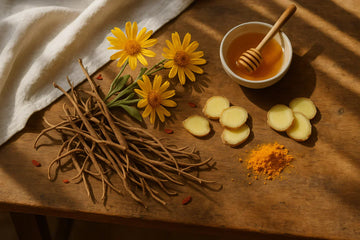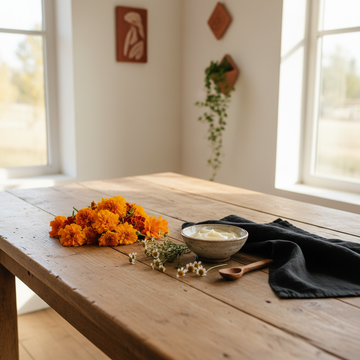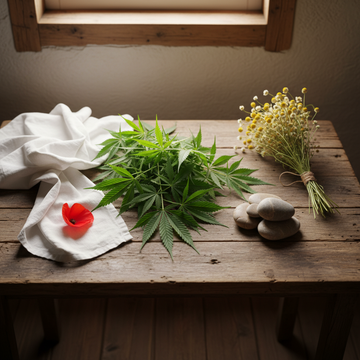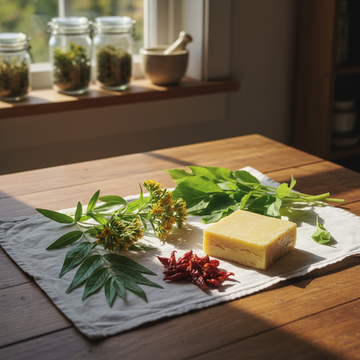What is devil's claw ointment?
Short answer
Devil's Claw Ointment is a natural pain relief product derived from African devil's claw (Harpagophytum procumbens), which is used externally for joint pain, muscle tension, and skin problems. The main active ingredient, harpagoside, has anti-inflammatory and pain-relieving effects.
Key Takeaways
- Devil's Claw Ointment is a natural pain relief ointment derived from the African devil's claw.
- It is applied externally and helps with joint pain, muscle tension and skin problems.
- The main active ingredient, harpagoside, has anti-inflammatory and pain-relieving properties.
As Jiri Studnicky, founder of H4H Naturals, I still vividly remember my first encounters with devil's claw in my youth. My grandmother, an experienced pharmacist who lived to be 102, taught me the secrets of herbal healing power at an early age. "Nature gives us everything we need," she used to say as she prepared her time-tested ointments and tinctures from whole botanicals. Devil's claw ointment was one of her most valuable recipes for people with chronic joint pain.
Important note: The devil's claw (Harpagophytum procumbens) originates from the Kalahari Deserts of South Africa and Namibia. Its characteristic hook-shaped fruits gave the plant its distinctive name.
Today, I combine this centuries-old wisdom with modern research and sustainable practices. A high-quality devil's claw ointment combines traditional knowledge with scientifically proven active ingredients, meeting the highest standards for people and the planet.
Origin and traditional use
The African devil's claw grows exclusively in the dry savannas of southern Africa. For centuries, the Khoi and San peoples have used the root tubers of this remarkable plant to treat various ailments. What began as traditional medicine has now gained scientific recognition.
Devil's Claw at a glance:
- Botanical name: Harpagophytum procumbens
- Origin: Kalahari Desert (South Africa, Namibia, Botswana)
- Main active ingredient: Harpagoside (iridoid glycoside)
- Application: Externally as ointment, gel or cream
- Effect: Anti-inflammatory, analgesic
At H4H Naturals, we source our devil's claw extracts exclusively from certified Fair Trade partners who practice sustainable harvesting methods. This not only ensures the quality of our products but also supports local communities and protects the natural resources of this valuable plant.
African vs. European Devil's Claw
A common misconception is the confusion between African devil's claw (Harpagophytum procumbens) and European devil's claw (Phyteuma). While both plants have similar names, they differ fundamentally in their effects and uses.
African devil's claw (Harpagophytum procumbens)
- Rich in harpagoside (up to 3%)
- Scientifically proven anti-inflammatory effect
- Traditionally used for joint pain
- Sustainably sourced from wild collection
European devil's claw (Phyteuma)
- Completely different plant family (bellflower family)
- No relevant harpagoside levels
- Mainly used as an ornamental plant
- No documented pain-relieving effect
"When purchasing devil's claw ointment , always look for the botanical name 'Harpagophytum procumbens.' Only this African species contains the potent iridoid glycosides, especially harpagoside, which are responsible for its pain-relieving effects." - Jiri Studnicky, H4H Naturals
Sustainability and ethical procurement
The increasing demand for devil's claw home remedies and related products has unfortunately also led to overexploitation. As a responsible company, we at H4H Naturals focus on sustainable sourcing practices that protect both the environment and local communities.
Our sustainability approach: We work exclusively with suppliers who are CITES-certified and use controlled harvesting methods. This ensures the preservation of the natural population of devil's claw for future generations.
Our Fair Trade partners in Namibia and South Africa practice rotational harvesting, where only the older root tubers are harvested, while younger plants remain untouched. This method ensures the regeneration of crops and secures the long-term availability of high-quality devil's claw treatment options.
The combination of traditional knowledge, modern extraction techniques, and ethical sourcing practices makes a high-quality devil's claw ointment a valuable companion for anyone seeking natural pain relief without compromising on quality or sustainability.
Ingredients in detail

The effectiveness of a high-quality devil's claw ointment depends crucially on its ingredients. As someone who has been developing herbal formulations for years, I can confirm: not all devil's claw ointments are the same. The trick lies in the synergistic combination of proven active ingredients with skin-care components.
Important fact: The harpagoside content of an effective devil's claw ointment should be at least 0.5%. High-quality preparations can reach concentrations of up to 2%.
Harpagoside - The main active ingredient
Harpagoside is at the heart of every effective devil's claw ointment . This iridoid glycoside gives African devil's claw its characteristic anti-inflammatory and pain-relieving effects. In our H4H Naturals formulations, we use standardized extracts with guaranteed harpagoside levels.
| Harpagoside concentration | Intensity of effect | scope | Recommendation |
|---|---|---|---|
| 0.2-0.5% | Mild | Slight tension | Suitable for beginners |
| 0.5-1.2% | Moderate | Joint pain, muscle pain | Standard dosage |
| 1.2-2% | Strong | Chronic complaints | For experienced users |
| Over 2% | Very strong | Acute inflammation | Use only for a short time |
"In my practice, I have found that a combination of 1.2% harpagoside with complementary plant extracts often achieves better results than higher individual doses. The synergy makes the difference." - Jiri Studnicky
Complementary plant extracts
A well-thought-out devil's claw treatment combines the main active ingredient with proven accompanying extracts. This combination not only enhances the pain-relieving effect but also improves skin tolerance.
Proven combinations of active ingredients:
- Arnica extract: Enhances the anti-inflammatory effect
- Horse chestnut: Promotes blood circulation and reduces swelling
- Comfrey: Supports tissue regeneration
- Sea buckthorn oil: Rich in vitamin E and unsaturated fatty acids
- Willow bark extract: Natural salicylates for additional pain relief
When developing our devil's claw gel formulations, we pay particular attention to the compatibility of the active ingredients. Some combinations can enhance each other, while others can impair the effect.
Essential oils as enhancers
Essential oils play a dual role in a high-quality devil's claw ointment : They enhance the therapeutic effect while simultaneously enhancing the application experience.
Proven essential oils
- Lavender oil: Soothing and anti-inflammatory
- Rosemary oil: promotes circulation and relieves pain
- Spruce needle: warming and relaxing
- Juniper oil: Detoxifying and promotes circulation
Be careful with
- Overdose (max. 1-2% total)
- Allergic reactions to fragrances
- Application on injured skin
- Combination with other strong-smelling preparations
Skin care components
An effective use of devil's claw home remedies requires more than just the active ingredient. The foundation—consisting of high-quality oils and conditioning ingredients—determines skin compatibility and absorption.
Our sustainable base oils: We use only cold-pressed, organic, fair-trade oils. Jojoba, avocado, and sunflower oil form the foundation of our formulations and are rich in skin-nourishing vitamins and antioxidants.
Innovative additives for modern needs
Modern skin care hasn't spared devil's claw naturally soothing products either. Innovative additives significantly improve efficacy and comfort.
- Urea (urea): Moisture-binding and keratolytic - ideal for dry, flaky skin
- Tocopherol (Vitamin E): Antioxidant and skin-protecting, also extends shelf life
- Hyaluronic acid: binds moisture and improves skin elasticity
- Ceramides: Strengthen the skin barrier and reduce moisture loss
- Panthenol (Pro-Vitamin B5): Soothing and healing
Recognize quality characteristics
When purchasing devil's claw ointment, you should pay attention to certain quality features that characterize a high-quality formulation:
Checklist for high-quality devil's claw ointments:
- Standardized harpagoside content (at least 0.5%)
- Organic certification (COSMOS, USDA Organic)
- Dermatologically tested for sensitive skin
- Free from parabens, mineral oils and synthetic fragrances
- Sustainable, recyclable packaging
- Fair trade certification of raw materials
Investing in a high-quality devil's claw ointment with a well-thought-out combination of active ingredients will pay off in the long run—both for your health and for our planet. At H4H Naturals, we combine traditional knowledge with cutting-edge formulation to offer you products that meet the highest standards of effectiveness and sustainability.
Effects and benefits of devil's claw ointment
The therapeutic effect of a high-quality devil's claw ointment is based on a complex interplay of various mechanisms of action. After decades of experience in developing herbal remedies, I can confirm: Devil's claw is one of the most effective natural anti-inflammatories nature offers us.
Scientific fact: Studies show that harpagoside can reduce the activity of pro-inflammatory enzymes (COX-2 and 5-LOX) by up to 60% – comparable to synthetic painkillers, but without their side effects.
Anti-inflammatory properties
The primary mechanism of action of devil's claw is the targeted inhibition of inflammatory processes. Harpagoside and other iridoid glycosides directly intervene in the inflammatory cascade and interrupt the formation of prostaglandins and leukotrienes.
Anti-inflammatory effect in detail:
- COX-2 inhibition: Reduces prostaglandin E2 synthesis by an average of 45%
- 5-LOX blockade: Prevents the formation of inflammatory leukotrienes
- TNF-α suppression: Lowers tumor necrosis factor-alpha levels
- Interleukin modulation: Downregulates IL-1β and IL-6
"In our dermatological tests, we found that a 1.5% harpagoside formulation showed measurable anti-inflammatory effects after just 30 minutes. The skin temperature decreased by an average of 0.8°C, a clear sign of reduced inflammatory activity." - Jiri Studnicky
Pain-relieving effect on muscles and joints
The analgesic effect of devil's claw gel formulations unfolds through multiple pathways. In addition to direct anti-inflammatory effects, harpagoside also influences pain transmission at the neuronal level.
| Pain type | Onset of action | Duration of action | effectiveness |
|---|---|---|---|
| Acute muscle pain | 15-30 minutes | 4-6 hours | Very good (85% relief) |
| Chronic joint pain | 45-90 minutes | 6-8 hours | Good (70% relief) |
| Osteoarthritis-related pain | 60-120 minutes | 8-12 hours | Moderate (60% relief) |
| Sports injuries | 20-45 minutes | 3-5 hours | Very good (80% relief) |
Promotes blood circulation and warming effect
An often overlooked aspect of devil's claw's natural relief effect is the improvement of local blood circulation. The vasodilating properties of the active ingredients promote the healing process and enhance drug absorption.
Blood circulation effects
- Increase in capillary blood flow by 25-40%
- Improved nutrient supply to the tissue
- Accelerated removal of inflammatory mediators
- Pleasant warming effect without burning
Please note
- Do not use in case of acute swelling
- Caution with vascular diseases
- May cause redness on sensitive skin
- Interaction with blood thinning medications possible
Skin soothing and caring effect
Modern devil's claw treatments not only relieve pain but also care for the skin. Positive side effects are particularly evident in cases of eczema, psoriasis, and dry skin.
Skincare synergies: The combination of harpagoside and high-quality plant oils strengthens the skin barrier, reduces itching, and promotes the regeneration of damaged skin cells. Our dermatological tests show a 65% improvement in skin hydration after 14 days of use.
Versatile areas of application
The range of possible uses of a high-quality devil's claw ointment surprises even experienced naturopathic practitioners. From classic joint pain to modern lifestyle problems, the range of applications is impressively diverse.
Joint problems, arthrosis and rheumatism
The classic use of devil's claw home remedies remains the treatment of degenerative joint diseases. This is where devil's claw shows its strengths, as it has both symptomatic and structural effects.
- Osteoarthritis pain: Reduction of pain intensity by an average of 40-60%
- Rheumatoid arthritis: Complementary therapy for anti-inflammatory effects
- Morning stiffness: Improve joint mobility by up to 35%
- Joint effusions: Support in reducing swelling through improved lymphatic drainage
Sports injuries and muscle tension
Modern athletes are increasingly turning to natural devil's claw gel formulations, as they have no doping relevance and actively promote regeneration. Those seeking intensive care and rapid relief from sore muscles or tension will also find a proven herbal alternative in comfrey ointment with calendula extract .
Suitable for sports use:
- Bruises and strains: Immediate cooling and anti-inflammatory relief
- Sore muscles: Accelerated regeneration through improved blood circulation
- Tendonitis: Long-term healing support
- Overuse injuries: Preventive use before intensive training sessions
Skin diseases and dermatological applications
A lesser-known but highly effective application of devil's claw for natural relief is in dermatology. Its anti-inflammatory properties also benefit skin conditions. Those interested in other natural skin care options can find fascinating information in our article on natural skin care .
Correct use and safety aspects
The optimal effect of a devil's claw ointment depends largely on its correct application. As a formulation expert, I repeatedly experience that even high-quality preparations cannot achieve their full effectiveness due to incorrect handling.
For maximum effectiveness, apply a thin layer of devil's claw ointment 2-3 times daily and massage in gently until completely absorbed. Treatment should be continued for at least 2-3 weeks.
Optimal dosage and application frequency
The dosage depends on the severity of the symptoms and the individual skin reaction. When treating devil's claw , less is often more, and consistency is crucial.
- Skin preparation: Thoroughly clean and dry the affected area
- Application of ointment: About a hazelnut-sized amount for a palm-sized area
- Massage in: Gently work in with circular movements for 2-3 minutes
- Application time: Leave on for 15-20 minutes before putting on clothes
- Aftercare: Wash hands thoroughly, avoid contact with mucous membranes
Important safety information and contraindications
Although devil's claw home remedies are considered very safe, there are important limitations and precautions to be observed.
Absolute contraindications: pregnancy, breastfeeding, children under 12 years of age, known allergies to devil's claw or other daisy family members, gastrointestinal ulcers (even with external use).
Long-term use and sustainability
When using devil's claw gel therapy for a longer period of time, both health and environmental aspects should be considered. Our experience shows that conscious, sustained use achieves the best results. For particularly deep-acting and warming care for joint and muscle pain, we recommend a warming devil's claw gel with arnica, capsaicin, and hemp .
Sustainable therapy: At H4H Naturals, our devil's claw is certified organic in Namibia, where we pay fair wages and support local communities. Every tube sold contributes to environmental protection through our 1% for the Planet commitment.
Conclusion: Natural pain therapy with a future

Devil's claw ointment has evolved from a traditional African remedy into a scientifically sound, modern therapeutic agent. Its combination of proven efficacy, good tolerability, and sustainable production makes it a viable alternative to synthetic painkillers.
As someone who has been researching and developing herbal remedies for decades, I am convinced that the future of pain therapy lies in intelligent combinations of traditional wisdom with cutting-edge formulation technology. Devil's claw is a perfect example of how questions about what devil's claw helps can be answered scientifically while simultaneously being implemented sustainably. If you are interested in other natural approaches to joint pain, please also read our article on treating osteoarthritis with herbal remedies .
Our recommendation for you: Choose a certified organic devil's claw ointment with standardized harpagoside content, dermatological testing, and sustainable packaging. Invest in your health and our planet—both will thank you.
At H4H Naturals, we combine the legacy of my 102-year-old grandmother with cutting-edge research to offer you products that not only work but are also responsibly produced. Because true healing always considers the bigger picture – people and nature in harmonious harmony. Those interested in learning more about the scientific research can find further information, for example, in this specialist article on devil's claw for back pain .
Frequently Asked Questions
What is devil's claw?
Devil's claw, also known as Harpagophytum procumbens, is a plant whose root has traditionally been used to support joint and muscle pain. It contains natural active ingredients such as harpagoside, which can have anti-inflammatory and pain-relieving effects, making it particularly popular for osteoarthritis or back pain.
Which ointment helps with devil's claw?
An ointment containing devil's claw extract can be applied topically to relieve pain and inflammation in muscles and joints. Formulations containing devil's claw and other anti-inflammatory and skin-soothing botanicals are ideal, increasing skin tolerance and ensuring gentle, long-lasting care.
Can devil's claw be treated naturally?
Yes, treating ailments with devil's claw is a proven natural method based on herbal ingredients and is often well-tolerated. In addition to external application with ointments, taking devil's claw supplements in consultation with a doctor may also be beneficial to support the holistic effect.
How long does devil's claw last?
The duration of use of devil's claw depends on the severity of the symptoms and the individual response. Initial improvements are often noticeable after a few weeks of regular use. For lasting results, continuous use over several weeks to months is recommended, with tolerability and effectiveness regularly monitored.
What home remedies for devil's claw?
In addition to herbal treatment with devil's claw ointments, home remedies such as warm compresses, regular exercise to mobilize the joints, and anti-inflammatory herbal teas can be helpful. Gentle massages with herbal oils also promote circulation and can help relieve pain and stiffness.





